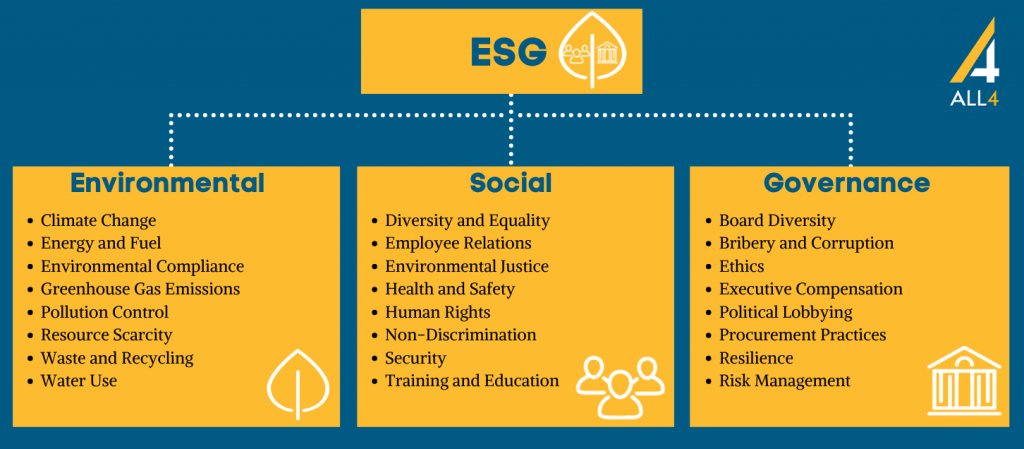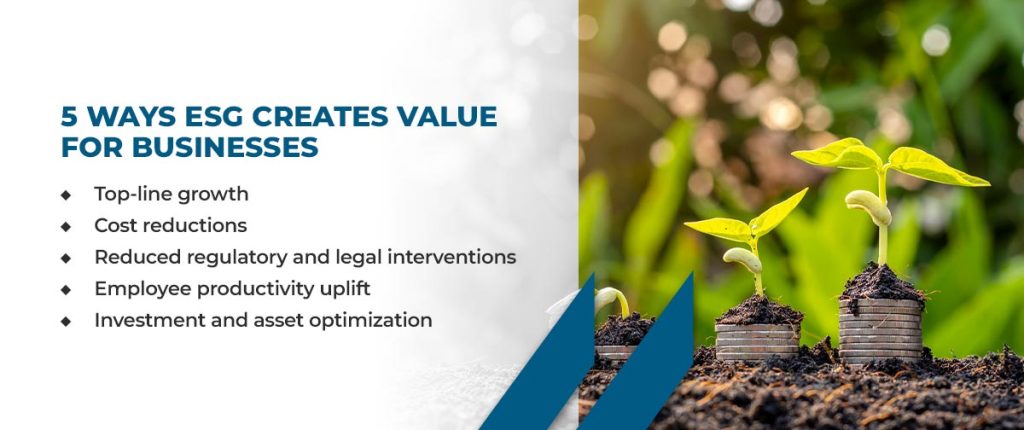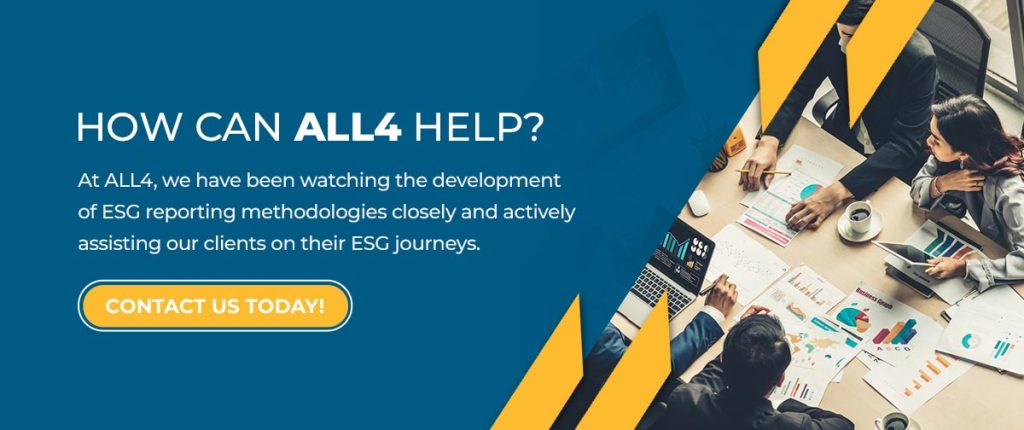ESG Meaning in Businesses
Posted: November 1st, 2021
Authors: Rich H.
|What is ESG?|Why Do I Care?|Are there Regulatory Drivers to ESG?|How do I Get Started on my ESG Journey?|What Are the Benefits and Risks of ESG Reporting?|How Can ALL4 Help?|
Environmental, Social, and Governance (ESG) is one of the most relevant topics in the investment and environmental worlds these days. ESG gives socially-conscious investors a set of criteria to follow to better screen potential business investments.
What Is ESG?
The criteria around Environmental are those that we as EHS professionals have known and worked around for years, essentially measures of how a company rates in its protection of the environment.
The Social criteria measure a company’s relationships with its employees, customers, other businesses, and the community around it. Perhaps the most visible of the social criteria right now is the relationship with neighboring communities as Environmental Justice (EJ) continues to be a key element of nearly every action the Biden administration takes.
Governance looks at a company’s leadership, how executives are compensated relative to the company’s sustainability goals, and the internal controls protecting the integrity of the company’s business information.
Why Do I Care?
ESG criteria are used by investment firms, shareholders, and other stakeholders to evaluate the environmental performance of businesses and grade or rank them in comparison to other companies to help inform investment decisions. ESG covers a broad range of topics as shown above. Companies disclose information about their goals and performance in an ESG or sustainability report outlining the company’s ESG footprint, challenges, successes, and plans.
As the number of firms and members of the public using ESG performance as an important criterion to determine whether to invest in a business or buy their products increases, having a positive ESG story to tell will become more and more important.
5 Ways ESG Creates Value for Businesses
It’s clear that ESG is important to include in your business practices from top to bottom. To help you better understand how this looks in a practical sense, here are five ways ESG can create value for your business:
- Top-line growth: A strong ESG framework is attractive to governing authorities, causing them to put more trust in such businesses. This opens the door for easier access to licenses and approvals that make business expansion easier. Many consumers will also preferentially buy from businesses whose ESG values align with their own.
- Cost reductions: One part of good ESG practices is being a steward of the environment, which includes being mindful of your business’s use of utilities and resources. Energy and water costs can increase rapidly, but an ESG framework will help your business use these things with greater mindfulness, reducing costs along the way.
- Reduced regulatory and legal interventions: ESG can give businesses greater strategic freedom by easing pressure from regulations. As your business aims to achieve its goals, having a strong ESG framework can help you avoid adverse government actions that could make achieving those goals difficult. Align your goals with ESG, and the government will look more favorably on your aspirations.
- Employee productivity uplift: With a strong ESG framework, you can attract high-quality candidates and keep your employees happy and productive. You’ll enjoy a lower employee turnover rate as you give your teams a greater sense of purpose. You can also show your employees that working for your business is actually making the world a better place, both environmentally and socially.
- Investment and asset optimization: An ESG framework can help your business put its capital into more sustainable, promising and robust investment opportunities. Your ESG values will guide your investment decisions away from areas that can see drastic reductions in market value due to environmental factors.
Are there Regulatory Drivers to ESG?
In a word, no, but there are numerous reporting frameworks. This creates both opportunities and challenges when developing ESG reports.
On the one hand, many of us are engineers or scientists and as such want concrete numbers and standards to target and comply with. On the other, the variety in reporting methodologies available allows a firm to choose the one that is the best fit for their sector or allows for the most positive ESG story.
There are at least 10 ESG reporting frameworks to choose from, each with its own metrics, methodology, and scoring system. Some are tuned to specific industries and sectors, while others focus on the needs of specific stakeholder groups.
Where possible, it is best to choose one that is both widely accepted and in use by companies in your sector so that comparisons can be made between your firm and those with which you compete. In recent months, several of these organizations have announced partnerships to merge their areas of expertise and provide a more complete overall reporting package.
Some of the most popular ESG reporting frameworks are:
- Global Reporting Initiative (GRI): The GRI was the first global standard for sustainability reporting, launched in 1997. It is still the most widely used ESG reporting framework, with over 80% of the world’s 250 largest corporations using it. GRI is popular because of its flexibility. There are 3 Universal Standards used by every organization reporting through GRI, but there are also numerous additional Topic Standards that can be used to prepare reports for specific sectors, users, or purposes. The GRI framework is continuously evolving to improve reporting on specific topics.
- Sustainability Accounting Standards Board (SASB): SASB is a non-profit organization that has developed global standards around identifying and communicating financial materiality information to investors. They have accomplished this by developing a materiality map, which contains metrics for 77 different industries. SASB assists in translating this materiality data into useful information for investors. Companies often pair the SASB materiality assessments with other standards like GRI, and in fact, SASB and GRI announced towards the end of last year they would be working together to promote greater transparency amongst reporting firms.
- Carbon Disclosure Project (CDP): Founded in 2000, CDP is one of the most common reporting frameworks and is used by nearly 10,000 companies worldwide. CDP focuses primarily on climate impacts like deforestation, water usage and carbon emissions. CDP takes the information collected during the annual reporting process and scores the company on its environmental actions. CDP provides metrics and Key Performance Indicators (KPIs) for firms to track and evaluate. Like SASB and GSI, CDP has recently announced plans with other reporting organizations.
- Climate Disclosure Standards Board (CDSB): The first CDSB framework was released in 2015 and is similar to the CDP in that the focus is environmental activity. Unlike the CDP, CDSB does not provide metrics or KPIs but relies on other organizations like CDP. CDSB’s goal is to integrate climate change data into mainstream financial reports required by the U.S. Securities and Exchange Commission (SEC) to promote connectivity between sustainability and corporate business strategy.
- The Task Force on Climate-Related Financial Disclosures (TCFD): The TCFD was established in 2015 and somewhat like the CDSB, is focused on creating consistent climate-related financial risk disclosures aimed at firms with financial interests including banks, shareholders and investors.
How Do I Get Started on my ESG Journey?
The good news is, regardless of whether you are aware of it or call it ESG, you already have! Most companies have been collecting data, especially greenhouse gas (GHG) emissions, for years to feed their sustainability or other corporate reports. In many ways, ESG can be looked at as an expansion of those efforts. The first step is to conduct internal benchmarking to understand what data you’ve been collecting, determine the accuracy of that data and identify the gaps in data collection and controls that need to be corrected.
The next step is a materiality assessment. Per the GRI, the definition of materiality is “Those topics that have a direct or indirect impact on an organization’s ability to create, preserve or erode economic, environmental, and social value for itself, its stakeholders and society at large.” However, materiality also has an external context, as you will evaluate what investors and other entities consider important.
Understanding the difference between the two and where the synergies lie is critical for maximizing your efforts in defining your ESG footprint and preventing wasting resources on things that don’t matter as much to the business or your target audience.
Once the benchmarking and materiality assessment is complete, the next phase is to identify and implement your reporting objectives, targets and KPIs, in alignment with your findings and chosen ESG goals and reporting methodology. This includes gaining alignment and approval all the way to the board level and assigning specific roles and responsibilities within the organization. Finally, developing a disclosure strategy, often with third-party certification, is critical in presenting a strong, defensible ESG report that satisfies your stakeholders’ requirements.
What Are the Benefits and Risks of ESG Reporting?
Aside from telling your ESG story and improving the organization’s reputation, the process of developing strong ESG reporting practices provides several internal benefits:
- Positive environmental impact: Sourcing ethically produced materials, measuring and reducing carbon emissions and managing your water usage are all parts of an ESG framework that can cause your business to have a positive impact on the environment.
- More convincing investment appeal: Investors will see your ESG framework as a commitment to long-term sustainability and profitability and see you as a wise business to invest in.
- Loyal customer base: Today’s customers choose businesses that align with their values. Therefore, an ESG framework can contribute to attracting like-minded customers who will remain loyal to your business. Conversely, many buyers are abandoning brands that show little interest in ESG efforts.
- Healthier corporate culture: You can attract and retain strong talent for your team by leaning into your ESG framework and values. Happy employees will enjoy their work while operating at healthy efficiency and productivity levels. Your teams will display better teamwork, and everyone will feel like they are a part of something bigger than themselves.
- Process development: An ESG framework forces the development of stronger data collection, assurance and control practices.
- Greater risk-benefit awareness: You can increase your business’s internal understanding of risks while finding more opportunities for improvement on many levels.
- Increased productivity and efficiency: An ESG framework will help your business achieve new levels of productivity and efficiency at points throughout the business.
- Improved relationship between finances and the environment: Your business can create a more concrete link between financial and environmental performance by establishing and abiding by an ESG framework.
- Better third-party relationships: An ESG framework will help you achieve improved awareness of the environmental footprint of your third-party suppliers.
ESG reporting does not come without potential risks, however. It is critical that statements made in an organization’s ESG reports are backed by concrete data and are easily defensible to prevent questions about the credibility of the report and accusations of greenwashing — outside stakeholders will be watching, and questions will be asked. It is critical to be prepared to answer those questions not only about your own activities but also those of the organizations with whom you partner.
How can ALL4 help?
At ALL4, we have been watching the development of ESG reporting methodologies closely and actively assisting our clients on their ESG journeys. We can help in several ways:
- Developing digital solutions for evaluating, tracking, and documenting sustainability, climate, and ESG projects and progress toward goals
- Researching issues of interest to internal and external stakeholders and developing goals
- Benchmarking across industries, geographies, companies or facilities to understand KPIs of interest or performance
- Reviewing current environmental footprint and resource use and developing strategies for reductions
- Conducting materiality assessments
- Assist in reviewing or developing a GHG inventory including Scope 1-3 emissions.
- Reviewing current ESG programs for gaps
- Developing corporate ESG strategies
- Creation of ESG reports
If you’d like to discuss your ESG approach and strategy, feel free to contact your ALL4 Project Manager or Rich Hamel. We’re happy to share what we’ve learned and assist you in making your ESG reporting as efficient and beneficial to you as possible. We’re here to help!





